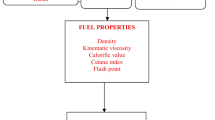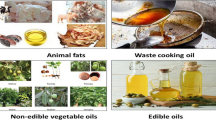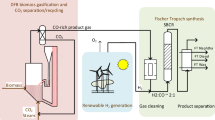Abstract
Individuals are exploring alternative fuels like biodiesel due to energy scarcity and environmental concerns. Biodiesel provides benefits such reusability, environmental friendliness, and recyclability. However, biodiesel’s lower calorific value and greater density might cause the engine to take longer to start, consume more gasoline, and emit more NOx. The highest heat release rate (HRRMax) of GAB10, GAB20 and GAB30 was cut by 11.53, 13.59 and 16.47%, respectively. The heat release rate (HRRMax) values of GAB10, GAB20 and GAB30 blends are 4.33%, 4.05%, and 1.39% higher, respectively, than GAB fuel when used in an 18.5 CR engine. The HRRMax of GAB10T, GAB20T and GAB30T increases by 3.46%, 2.7%, and 2.27%, respectively, compared to GAB gasoline when the engine compression ratio is 18.5. When nanoparticles were added to clean diesel fuel, the manner it burned improved, particularly at a compression ratio (CR) of 16.5. The stretching vibration of C = O esters is shown by the peaks at 1744 and 1742 cm-1. Peaks at 611 cm-1 indicate the presence of a strong C-Br stretching halo complex. Peaks at 547 cm-1 represent Al-O-Al. Ti-O is represented by peaks at 431 cm-1. Nanotechnology has grown in importance in recent decades because to its obvious advantages in a variety of fields, including environmental clean-up. When nano compounds were utilised, the time it required to ignite the fuel was reduced, resulting in a shorter burning period. NOx emissions from Al2O3 and TiO2 nanoparticles are reduced by 5.5% and 3.6%, respectively, as compared to their respective biodiesel mixes. The nan additions effectively reduced NOx emissions at peak load. As a result of breakdown of NOx a harmful gas to CO2 led to an slight increase in carbon dioxide emissions into the atmosphere. Simultaneously, there has been a substantial reduction in particulate matter pollution.











Similar content being viewed by others
Data availability
The datasets used and/or analysed during the current study are available from the corresponding author upon reasonable request.
Abbreviations
- GA:
-
Guizotia abyssinica (L.)
- GAB:
-
Guizotia abyssinica biodiesel
- Al2O3 :
-
Aluminium oxide
- TiO2 :
-
Titanium dioxide
- GAB10 :
-
Diesel 90% + Biodiesel 10%
- GAB20 :
-
Diesel 80% + Biodiesel 20%
- GAB30 :
-
Diesel 70% + Biodiesel 30%
- GAB10A:
-
Diesel 90% + Biodiesel 10% + Al2O3 100ppm
- GAB10T:
-
Diesel 90% + Biodiesel 10% + TiO2 100ppm
- GAB20A:
-
Diesel 80% + Biodiesel 20% + Al2O3 100ppm
- GAB20T:
-
Diesel 80% + Biodiesel 20% + TiO2 100ppm
- GAB30A:
-
Diesel 70% + Biodiesel 30% + Al2O3 100ppm
- GAB30T:
-
Diesel 70% + Biodiesel 30% + TiO2 100ppm
- MFVCR:
-
Multi fuel variable compression ratio
- CR:
-
Compression ratio
- HRR:
-
Heat release rate
- HRRMax :
-
Maximum heat release rate
- CD:
-
Combustion duration
- NOx :
-
Nitrogen oxide
- CO2 :
-
Carbon dioxide
- CO:
-
Carbon monoxide
- PM:
-
Particulate matter
References
Aalam, C. S., Saravanan, C. G., & Kannan, M. (2015). Experimental investigations on a CRDI system assisted diesel engine fuelled with aluminium oxide nanoparticles blended biodiesel. Alexandria Eng J, 54, 351–358. https://doi.org/10.1016/j.aej.2015.04.009.
Abishek, M. S., Kachhap, S., & Singh, P. S. (2023a). In B. P. Swain (Ed.), Biodiesel production by non-edible Cascabela Ovata seeds through Solvent methods (pp. 119–131). Springer Nature Singapore. Recent Adv. Mater.
Abishek, M. S., Kachhap, S., & Verma, T. N. (2023b). Validation and optimization of Spirulina Microalgae biodiesel using different metallic nano-additives numerically. Aip Conference Proceedings, 2821, 80009. https://doi.org/10.1063/5.0158751.
Abishek, M. S., Kachhap, S., Rajak, U., Verma, T. N., Singh, T. S., Shaik, S., Cuce, E., & Alwetaishi, M. (2024a). Alumina and titanium nanoparticles to diesel–Guizotia abyssinica (L.) biodiesel blends on MFVCR engine performance and emissions. Sustain Energy Technol Assessments, 61, 103580. https://doi.org/10.1016/j.seta.2023.103580.
Abishek, M. S., Kachhap, S., Rajak, U., Verma, T. N., Giri, N. C., AboRas, K. M., & ELrashidi, A. (2024b). Exergy-energy, sustainability, and emissions assessment of Guizotiaabyssinica (L.) fuel blends with metallic nano additives. Scientific Reports, 14, 1–16. https://doi.org/10.1038/s41598-024-53963-8.
Anand, K., Sharma, R. P., & Mehta, P. S. (2011). Experimental investigations on combustion, performance and emissions characteristics of neat karanji biodiesel and its methanol blend in a diesel engine. Biomass and Bioenergy, 35, 533–541. https://doi.org/10.1016/j.biombioe.2010.10.005.
Anchupogu, P., Rao, L. N., & Banavathu, B. (2018). Effect of alumina nano additives into biodiesel-diesel blends on the combustion performance and emission characteristics of a diesel engine with exhaust gas recirculation. Environmental Science and Pollution Research, 25, 23294–23306. https://doi.org/10.1007/s11356-018-2366-7.
Appavu, P., Madhavan, V. R., Venu, H., & Jayaraman, J. (2020). A novel alternative fuel mixture (diesel–biodiesel–pentanol) for the existing unmodified direct injection diesel engine: Performance and emission characteristics, https://doi.org/10.1139/tcsme-2019-0049.
Bai, L., Tajikfar, A., Tamjidi, S., Foroutan, R., & Esmaeili, H. (2021). Synthesis of MnFe 2 O 4 @ graphene oxide catalyst for biodiesel production from waste edible oil. Renew Energy, 170, 426–437. https://doi.org/10.1016/j.renene.2021.01.139.
D’Silva, R., Binu, K. G., & Bhat, T. (2015). Performance and Emission characteristics of a C.I. Engine Fuelled with Diesel and TiO2 nanoparticles as Fuel Additive. Mater Today Proc, 2, 3728–3735. https://doi.org/10.1016/j.matpr.2015.07.162.
Dhahad, H. A., & Chaichan, M. T. (2020). The impact of adding nano-Al2O3 and nano-ZnO to Iraqi diesel fuel in terms of compression ignition engines’ performance and emitted pollutants. Therm Sci Eng Prog, 18, 100535. https://doi.org/10.1016/j.tsep.2020.100535.
El-Seesy, A. I., Attia, A. M. A., & El-Batsh, H. M. (2018). The effect of aluminum oxide nanoparticles addition with Jojoba methyl ester-diesel fuel blend on a diesel engine performance, combustion and emission characteristics. Fuel, 224, 147–166. https://doi.org/10.1016/j.fuel.2018.03.076.
Fan, M., Li, Z., Song, S., Alahmadi, T. A., Alharbi, S. A., Shanmugam, S., Jhanani, G. K., & Brindhadevi, K. (2023). Optimizing biodiesel blends with green hydrogen fuel: A study on combustion duration, fuel mass burnt, engine performance and emissions. Fuel, 346, 128340. https://doi.org/10.1016/j.fuel.2023.128340.
Fayad, M. A. (2020). Investigating the influence of oxygenated fuel on particulate size distribution and NOX control in a common-rail diesel engine at rated EGR levels. Therm Sci Eng Prog, 19, 100621. https://doi.org/10.1016/j.tsep.2020.100621.
Fayad, M. A., Fernàndez-Rodríguez, D., Herreros, J. M., Lapuerta, M., & Tsolakis, A. (2018). Interactions between aftertreatment systems architecture and combustion of oxygenated fuels for improved low temperature catalysts activity. Fuel, 229, 189–197. https://doi.org/10.1016/j.fuel.2018.05.002.
Fayad, M. A., Tsolakis, A., & Martos, F. J. (2020). Influence of alternative fuels on combustion and characteristics of particulate matter morphology in a compression ignition diesel engine. Renew Energy, 149, 962–969. https://doi.org/10.1016/j.renene.2019.10.079.
Gad, M. S., He, Z., El-Shafay, A. S., & El-Seesy, A. I. (2021). Combustion characteristics of a diesel engine running with Mandarin essential oil -diesel mixtures and propanol additive under different exhaust gas recirculation: Experimental investigation and numerical simulation, Case Stud. Thermal Engineering, 26, 101100. https://doi.org/10.1016/j.csite.2021.101100.
Ghanbari, M., Mozafari-Vanani, L., Dehghani-Soufi, M., & Jahanbakhshi, A. (2021). Effect of alumina nanoparticles as additive with diesel–biodiesel blends on performance and emission characteristic of a six-cylinder diesel engine using response surface methodology (RSM), Energy Convers. Manag X, 11, 100091. https://doi.org/10.1016/j.ecmx.2021.100091.
Gharehghani, A., Mirsalim, M., & Hosseini, R. (2020). Effects of waste fi sh oil biodiesel on diesel engine combustion characteristics and emission. Renew Energy, 101, 930–936. https://doi.org/10.1016/j.renene.2016.09.045.
Ghodrati, M., Mousavi-Kamazani, M., & Zinatloo-Ajabshir, S. (2020). Zn3V3O8 nanostructures: Facile hydrothermal/solvothermal synthesis, characterization, and electrochemical hydrogen storage. Ceramic International, 46, 28894–28902. https://doi.org/10.1016/j.ceramint.2020.08.057.
Heidari-Maleni, A., Mesri-Gundoshmian, T., Jahanbakhshi, A., Karimi, B., & Ghobadian, B. (2021). Novel environmentally friendly fuel: The effect of adding graphene quantum dot (GQD) nanoparticles with ethanol-biodiesel blends on the performance and emission characteristics of a diesel engine. NanoImpact, 21, 100294. https://doi.org/10.1016/j.impact.2021.100294.
Imdadul, H. K., Masjuki, H. H., Kalam, M. A., Zulkifli, N. W. M., Rashed, M. M., Rashedul, H. K., Monirul, I. M., & Mosarof, M. H. (2015). A comprehensive review on the assessment of fuel additive effects on combustion behavior in CI engine fuelled with diesel biodiesel blends. Rsc Advances, 5, 67541–67567. https://doi.org/10.1039/c5ra09563h.
Jin, Y., Dou, S., Yang, Q., Xu, X., Fu, Q., & Pan, L. (2021). Performance characteristics of a scramjet engine using JP-10 fuel containing aluminum nanoparticles. Acta Astronautica, 185, 70–77. https://doi.org/10.1016/j.actaastro.2021.04.044.
Karisathan Sundararajan, N., & Ammal, A. R. B. (2018). Improvement studies on emission and combustion characteristics of DICI engine fuelled with colloidal emulsion of diesel distillate of plastic oil, TiO2 nanoparticles and water. Environmental Science and Pollution Research, 25, 11595–11613. https://doi.org/10.1007/s11356-018-1380-0.
Karthikeyan, S., & Prathima, A. (2017). Environmental effect of CI engine using microalgae methyl ester with doped nano additives. Transp Res Part D Transp Environ, 50, 385–396. https://doi.org/10.1016/j.trd.2016.11.028.
Kishore Pandian, A., Munuswamy, D. B., Radhakrishana, S., Bathey Ramakrishnan, R. B., Nagappan, B., & Devarajan, Y. (2017). Influence of an oxygenated additive on emission of an engine fueled with neat biodiesel. Petroleum Science, 14, 791–797. https://doi.org/10.1007/s12182-017-0186-x.
Krupakaran, R. L., Hariprasasd, T., Gopalakrishna, A., & Babu, P. (2016). The performance and exhaust emissions investigation of a diesel engine using γ-Al2O3 nanoparticle additives to biodiesel. Carbon Management, 7, 233–241. https://doi.org/10.1080/17583004.2016.1218713.
Kumar, S. (2021). Production and optimization from Karanja oil by adaptive neuro-fuzzy inference system and response surface methodology with modified domestic microwave. Fuel, 296, 120684. https://doi.org/10.1016/j.fuel.2021.120684.
Machado, S., Pacheco, J. G., Nouws, H. P. A., Albergaria, J. T., & Delerue-Matos, C. (2015). Characterization of green zero-valent iron nanoparticles produced with tree leaf extracts. Science of the Total Environment, 533, 76–81. https://doi.org/10.1016/j.scitotenv.2015.06.091.
Mirbagheri, S. A., Safieddin Ardebili, S. M., Kiani Deh, M., & Kiani (2020). Modeling of the engine performance and exhaust emissions characteristics of a single-cylinder diesel using nano-biochar added into ethanol-biodiesel-diesel blends. Fuel, 278, https://doi.org/10.1016/j.fuel.2020.118238.
Mirgane, N. A., Shivankar, V. S., Kotwal, S. B., Wadhawa, G. C., & Sonawale, M. C. (2020). Waste pericarp of ananas comosus in green synthesis zinc oxide nanoparticles and their application in waste water treatment. Mater Today Proc, 37, 886–889. https://doi.org/10.1016/j.matpr.2020.06.045.
Nanthagopal, K., Ashok, B., Tamilarasu, A., Johny, A., & Mohan, A. (2017). Influence on the effect of zinc oxide and titanium dioxide nanoparticles as an additive with Calophyllum inophyllum methyl ester in a CI engine. Energy Convers Manag, 146, 8–19. https://doi.org/10.1016/j.enconman.2017.05.021.
Naseem, T., & Durrani, T. (2021). The role of some important metal oxide nanoparticles for wastewater and antibacterial applications: A review. Environ Chem Ecotoxicol, 3, 59–75. https://doi.org/10.1016/j.enceco.2020.12.001.
Nour, M., EL-Seesy, A. I., Abdel-Rahman, A. K., & Bady, M. (2018). Influence of adding aluminum oxide nanoparticles to diesterol blends on the combustion and exhaust emission characteristics of a diesel engine. Exp Therm Fluid Sci, 98, 634–644. https://doi.org/10.1016/j.expthermflusci.2018.07.009.
Pan, S., Wei, J., Tao, C., Lv, G., Qian, Y., Liu, Q., & Han, W. (2021). Discussion on the combustion, performance and emissions of a dual fuel diesel engine fuelled with methanol-based CeO2 nanofluids. Fuel, 302, 121096. https://doi.org/10.1016/j.fuel.2021.121096.
Patel, C., Chandra, K., Hwang, J., Agarwal, R. A., Gupta, N., Bae, C., Gupta, T., & Agarwal, A. K. (2019). Comparative compression ignition engine performance, combustion, and emission characteristics, and trace metals in particulates from Waste cooking oil, Jatropha and Karanja oil derived biodiesels. Fuel, 236, 1366–1376. https://doi.org/10.1016/j.fuel.2018.08.137.
Praveen, A., Lakshmi Narayana Rao, G., & Balakrishna, B. (2018). Performance and emission characteristics of a diesel engine using Calophyllum Inophyllum biodiesel blends with TiO2 nanoadditives and EGR. Egypt J Pet, 27, 731–738. https://doi.org/10.1016/j.ejpe.2017.10.008.
Rajak, U., & Verma, T. N. (2019). A comparative analysis of engine characteristics from various biodiesels: Numerical study, Energy Convers. Manag, 180, 904–923. https://doi.org/10.1016/j.enconman.2018.11.044.
Reddy, M. J., Rakesh, N. S., Jayaraman, J., Anand, K. V., Appavu, P., & Arunkumar, T. (2021). Effect of novel bio-waste derived nano particles as additives on the performance of diesel engine fuelled with waste cooking oil biodiesel blends. Mater Today Proc, 44, 3530–3535. https://doi.org/10.1016/j.matpr.2020.09.292.
Samadi Kazemi, M., & Sobhani, A. (2023). CuMn2O4/chitosan micro/nanocomposite: Green synthesis, methylene blue removal, and study of kinetic adsorption, adsorption isotherm experiments, mechanism and adsorbent capacity. Arabian Journal of Chemistry, 16, 104754. https://doi.org/10.1016/j.arabjc.2023.104754.
Saxena, V., Kumar, N., & Saxena, V. K. (2017). A comprehensive review on combustion and stability aspects of metal nanoparticles and its additive effect on diesel and biodiesel fuelled C.I. engine. Renewable and Sustainable Energy Reviews, 70, 563–588. https://doi.org/10.1016/j.rser.2016.11.067.
Shaafi, T., & Velraj, R. (2015). Influence of alumina nanoparticles, ethanol and isopropanol blend as additive with diesel-soybean biodiesel blend fuel: Combustion, engine performance and emissions. Renew Energy, 80, 655–663. https://doi.org/10.1016/j.renene.2015.02.042.
Shamun, S., Belgiorno, G., Di Blasio, G., Beatrice, C., Tunér, M., & Tunestål, P. (2018). Performance and emissions of diesel-biodiesel-ethanol blends in a light duty compression ignition engine. Applied Thermal Engineering, 145, 444–452. https://doi.org/10.1016/j.applthermaleng.2018.09.067.
Sungur, B., Topaloglu, B., & Ozcan, H. (2016). Effects of nanoparticle additives to diesel on the combustion performance and emissions of a flame tube boiler. Energy, 113, 44–51. https://doi.org/10.1016/j.energy.2016.07.040.
Vanitha, N., Revathi, T., Gopalakrishnan, R., & Jeyalakshmi, R. (2021). Effect of TiO2, Al2O3and CaCO3nano-Additives in singular, binary and ternary forms on the mechanical, thermal and microstructural propertites of fly ash supplemented cement matrix. Mater Today Proc, 47, 871–879. https://doi.org/10.1016/j.matpr.2021.04.088.
Venu, H., & Madhavan, V. (2016). Effect of Al2O3 nanoparticles in biodiesel-diesel-ethanol blends at various injection strategies: Performance, combustion and emission characteristics. Fuel, 186, 176–189. https://doi.org/10.1016/j.fuel.2016.08.046.
Vigneswaran, R., Balasubramanian, D., & Sastha, B. D. S. (2021). Performance, emission and combustion characteristics of unmodified diesel engine with titanium dioxide (TiO2) nano particle along with water-in-diesel emulsion fuel. Fuel, 285, 119115. https://doi.org/10.1016/j.fuel.2020.119115.
Yesilyurt, M. K. (2020). A detailed investigation on the performance, combustion, and exhaust emission characteristics of a diesel engine running on the blend of diesel fuel, biodiesel and 1-heptanol (C7 alcohol) as a next-generation higher alcohol. Fuel, 275, 117893. https://doi.org/10.1016/j.fuel.2020.117893.
Yousefi, S. R., Amiri, O., & Salavati-Niasari, M. (2019). Control sonochemical parameter to prepare pure Zn0.35Fe2.65O4 nanostructures and study their photocatalytic activity. Ultrasonics Sonochemistry, 58, 104619. https://doi.org/10.1016/j.ultsonch.2019.104619.
Yousefi, S. R., Alshamsi, H. A., Amiri, O., & Salavati-Niasari, M. (2021). Synthesis, characterization and application of Co/Co3O4 nanocomposites as an effective photocatalyst for discoloration of organic dye contaminants in wastewater and antibacterial properties. Journal of Molecular Liquids, 337, 116405. https://doi.org/10.1016/j.molliq.2021.116405.
Yuvarajan, D., Dinesh Babu, M., BeemKumar, N., Amith, P., & Kishore (2018). Experimental investigation on the influence of titanium dioxide nanofluid on emission pattern of biodiesel in a diesel engine. Atmos Pollut Res, 9, 47–52. https://doi.org/10.1016/j.apr.2017.06.003.
Zinatloo-Ajabshir, S., & Salavati-Niasari, M. (2019). Preparation of magnetically retrievable CoFe2O4@SiO2@Dy2Ce2O7 nanocomposites as novel photocatalyst for highly efficient degradation of organic contaminants. Compos Part B Eng, 174, 106930. https://doi.org/10.1016/j.compositesb.2019.106930.
Zinatloo-Ajabshir, S., Morassaei, M. S., & Salavati-Niasari, M. (2019). Eco-friendly synthesis of nd 2 sn 2 O 7 –based nanostructure materials using grape juice as green fuel as photocatalyst for the degradation of erythrosine. Compos Part B Eng, 167, 643–653. https://doi.org/10.1016/j.compositesb.2019.03.045.
Author information
Authors and Affiliations
Corresponding authors
Ethics declarations
Conflict of interest
The authors declare that they have no known competing financial interests or personal relationships that could have appeared to influence the work reported in this paper. The Authors declare the following financial interests/personal relationships which may be considered as potential competing interests.
Additional information
Publisher’s Note
Springer Nature remains neutral with regard to jurisdictional claims in published maps and institutional affiliations.
Rights and permissions
Springer Nature or its licensor (e.g. a society or other partner) holds exclusive rights to this article under a publishing agreement with the author(s) or other rightsholder(s); author self-archiving of the accepted manuscript version of this article is solely governed by the terms of such publishing agreement and applicable law.
About this article
Cite this article
Abishek, M., Kachhap, S., Rajak, U. et al. Analysis and optimization of Guizotia abyssinica (L.) with alumina, titanium and diesel blends on DI engine combustion and emissions. Environ Dev Sustain (2024). https://doi.org/10.1007/s10668-024-04841-w
Received:
Accepted:
Published:
DOI: https://doi.org/10.1007/s10668-024-04841-w




